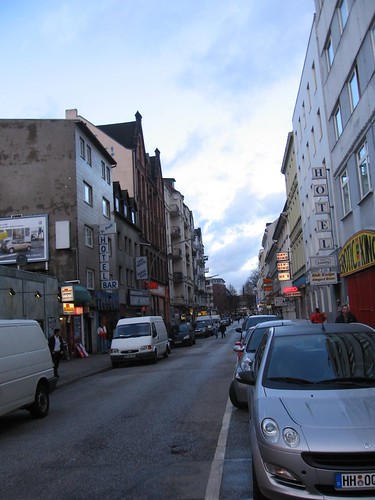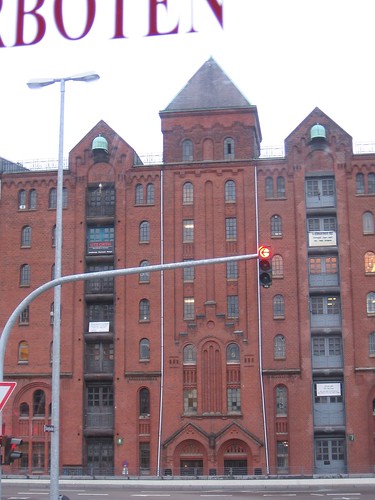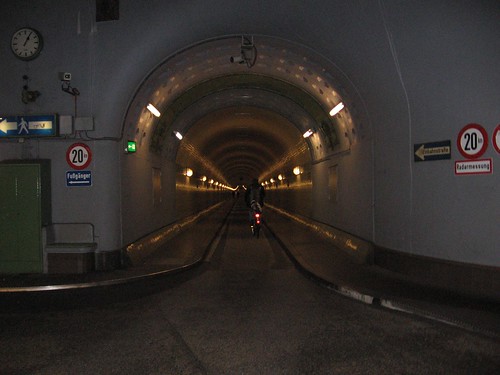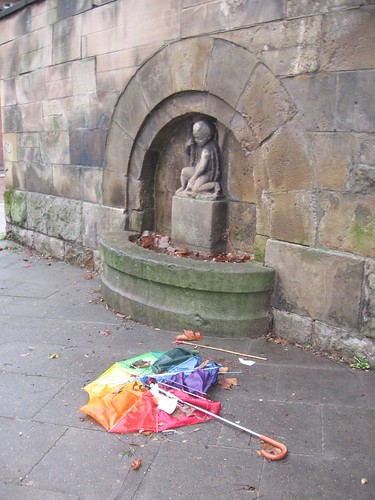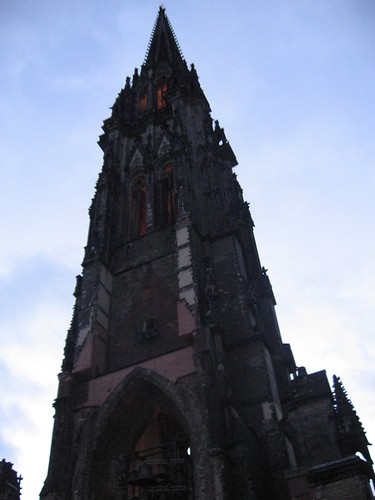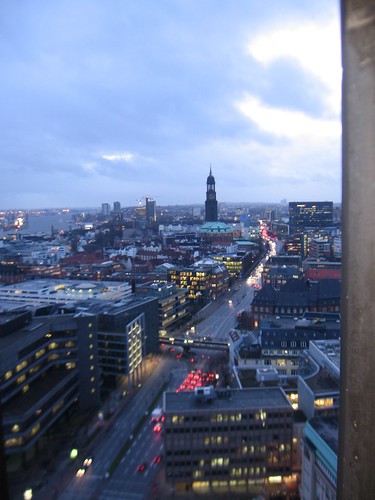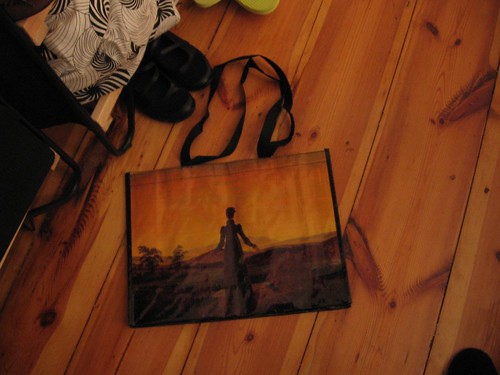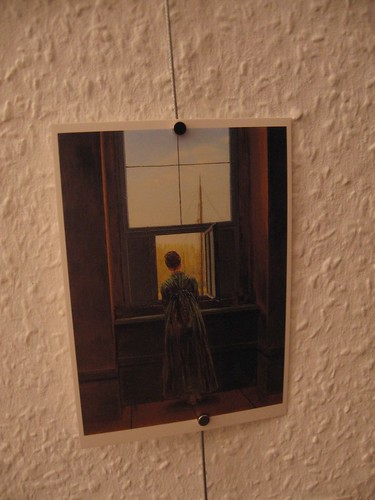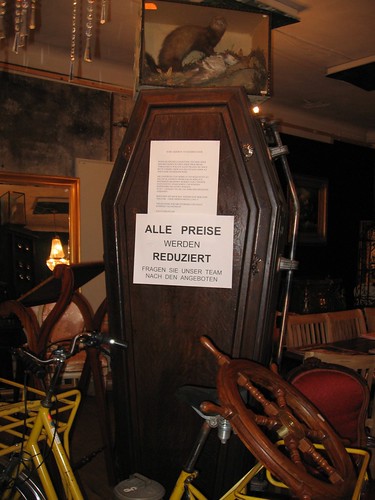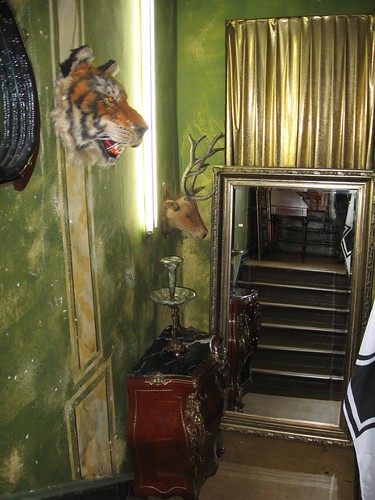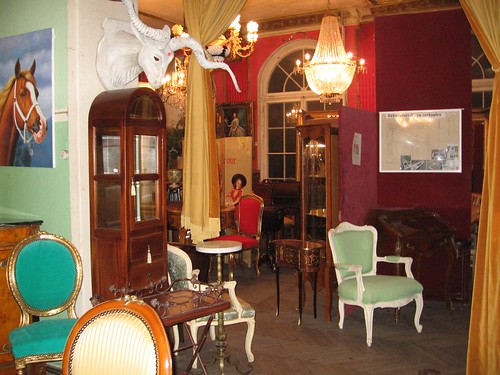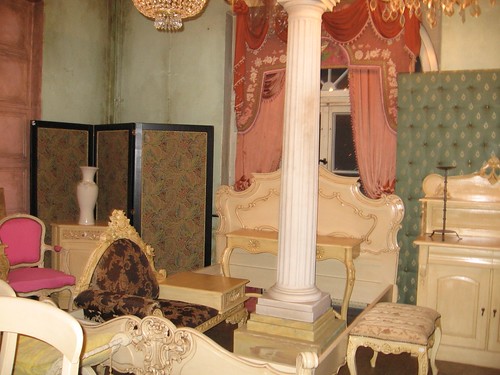It was a beautiful day on Saturday: the fields were green, the sun was shining, and it felt almost like spring. It was the perfect day to hop a train and head for the countryside, and I did. However, since
this was my final destination, it wasn't exactly fun. Spending a day touring the grounds of a concentration camp, including the crematorium, and having the gruesome acts of concentration camp guards described to you doesn't exactly make for a rollicking good time, but Ravensbrück was very interesting and I am glad I went.
Ravensbrück was a female prison located a few hours from Berlin; it was a bit of a catch-all, housing Sinti and Roma, Jewish, and so-called anti-social women (
asozial), as well as political prisoners and foreigners (wives of Polish intelligentsia, members of the French and Austrian resistance movements). All told, about 130,000 women from more than forty countries passed through Ravensbrück. It is unknown how many perished there, but estimates range from 40,000 to 90,000.
Lots of the camp has survived, since it was used by the Soviets until the 1990s. Still standing are the main building (Kommandantur), part of the original wall, clothing factory, utilities building, the warder's houses, the private houses for the SS personnel (the commandant, the doctors, etc.) and their families, the jail, and the crematorium. It was the first time I'd seen one intact: the ovens from Sachsenhausen are ruins and even though one of the crematoriums (crematoria?) at Dachau is still standing, I don't think it's open to the public (either that or I don't remember seeing it, which seems unlikely). It was chilling to stand in that building and look at the ovens and know that thousands of bodies were burned there, with their ashes then dumped in the lake.
One of the most striking features of Ravensbrück is in fact the lake. It seems like some kind of twisted joke that the location of a concentration camp could be so
beautiful. Located just outside of the town of Fürstenberg (Havel), Ravensbrück is surrounded by lush green woods and located right on a lake; it's downright picturesque, in fact. Standing at the camp's south edge you can see across the lake into the pretty little town, complete with cute cottages and brick church steeple. Our guide pointed out that Ravensbrück was located so close to the town its residents had to have smelled the crematorium, which brought home another fact about the Holocaust that is often forgotten: camps weren't all secreted away in remote locations in the east. Some, like Sachsenhausen and Ravensbrück, were located not too far to big cities and within sight of small towns. Many residents (and the reverend) could see Ravensbrück from their windows, and there must have been constant activity flowing from the camp to the town and back. Prisoners were marched through town on their way to work at various factories (like
Siemens), and local merchants delivered food and supplies to the camp. Even if residents believed, as most claimed, that only true
Volksfeinde (enemies of the people) were imprisoned there, don't you wonder if they ever had doubts? If it ever crossed their minds that something wasn't right? Like when they saw columns of women pass by with shaved heads and gaunt faces? Or when they smelled the burning bodies?
*****
There was a pretty good exhibit about the camp wardens (who were all women), with lots of biographical information. It was striking how alike they were: young women (who started working there at the age of 18 or 19, meaning they were children or teenagers when the Nazis came to power), with no education or training. Some were drafted into service, but most signed up voluntarily. They probably considered it a good job. It paid well, was in a beautiful location and nice, lakefront housing was provided. The exhibit managed to avoid the clichés that usually fill exhibits about the perpetrators of the Holocaust, instead giving lots of information about the guards, their training, behavior in the camp, everyday lives and, in some cases, post-war trials and sentences. There were drawings of the camp by former prisoners and also lots of media (videos, news reports, interviews), so you could listen to the children of Ravensbrück guards voice their almost desperate need to believe their mothers didn't commit terrible crimes, or how the warders themselves rationalized their work at the camp, claiming they were drafted and had no choice, or presenting themselves as victims. (One woman described how the inmates would often leave food for her, because they knew how hungry she always was).
It was not without its flaws, though: almost every video screen was right across from a window, causing glare, and there were these strange stone walls running throughout the exhibit that were placed at funny angles. (Seriously, was just hanging the exhibition pieces on the original, structural walls too blasé?) I was also annoyed that the exhibit translated the German word "Aufseherin" as matron. I realize that technically matron can refer to a woman who works in a prison, but I prefer the words supervisor, overseer, and warden to matron. They seem much more descriptive. "Matron" can refer to a dainty little widow who sips tea in pearls and gloves, and it seems inappropriate when applied to the vicious, uniformed young women leading attack dogs on leashes. Oh, and the exhibit stank; it literally
smelled, apparently due to the glue they used in putting it together.
The state of Brandenburg apparently deserves a prize for the sheer number of completely inappropriate things they've done with Ravensbrück. Most of the houses where the warders lived have been turned into, get this, a
youth hostel. (In fairness, its
website implies it is used for school trips for groups studying the Holocaust.) It just seems morbid that on your bike tour of northern Germany you can spend the night sleeping in the same room as someone who spent their days terrorizing inmates--sicking dogs on them, beating them, starving them.
But just in case you have such a wonderful time staying at the concentration camp-cum-hostel that you can't imagine every leaving, you might be able to actually
buy one of the houses used by the upper-level SS personnel at the camp. According to our guide the state of Brandenburg is looking to be rid of the half a dozen or so little villas that remain. So... if you're looking for lovely lakefront property in Brandenburg with a great view not only of forest and lake but also concentration camp, this is the place for you.
Not that the German government really does a much better job of dealing with history than the individual states. After all, it wasn't until the year
2000 that the former prisoners from the youth camp down the road were even recognized as victims. Everyone at that camp had been designated as anti-social and the designation followed them after the war. Nevermind that the Nazis designated people as
asozial for transgressions like having too many boyfriends or listening to the wrong music (swing). They, like the women forced to work at camp brothels I blogged about
yesterday, were considered at fault for their own incarceration and denied recognition for far too long.
Clearly, Germany is still struggling with the past, but as I walked the grounds of Ravensbrück I realized that I was, too. It seems wrong to sell off part of the camp, be it to a Buddhist organization or a private family, and I balked at the idea of filling up the warder's residences with backpackers. Yet at the same time, when our guide described how shocked she was at first to see students sit down and eat their lunches right after she told them about the crematorium, my first thought was, "But kids have to eat, and their enjoying their
Pausebrot in view of the camp doesn't undo its history or the magnitude of what happened here." And her stated refusal to swim or boat in the neighboring lake because it was where prisoners' ashes were disposed struck me as simply too much.
How long before life can return to normal? The concentration camp at Ravensbrück has been preserved; it is filled with historical documents, artifacts and exhibits. Is it really so bad if an empty building is sold to someone who will use it? Or if five unused residences are opened up to schoolgroups and students? History isn't being ignored or forgotten, and I wonder if it's really more respectful to let them sit empty, fill up with rats and bats and slowly rot away.
As I stood in that idyllic location, staring at the pretty little town and watching the sun glint off the lake, I realized that there are no right answers; there is no perfect way to deal with a place like Ravensbrück. As I turned my back to the lake to look at the crematorium, I also realized how incomprehensible it all is. How could it happen? No matter how many camps you visit, how many films you see, books you read or testimony you hear, it is still impossible to grasp.
I guess all that remains is for you to do the best you can, to continue to watch and listen and read, to not forget, to go and bear witness.
Labels: feminist thoughts, Germany




